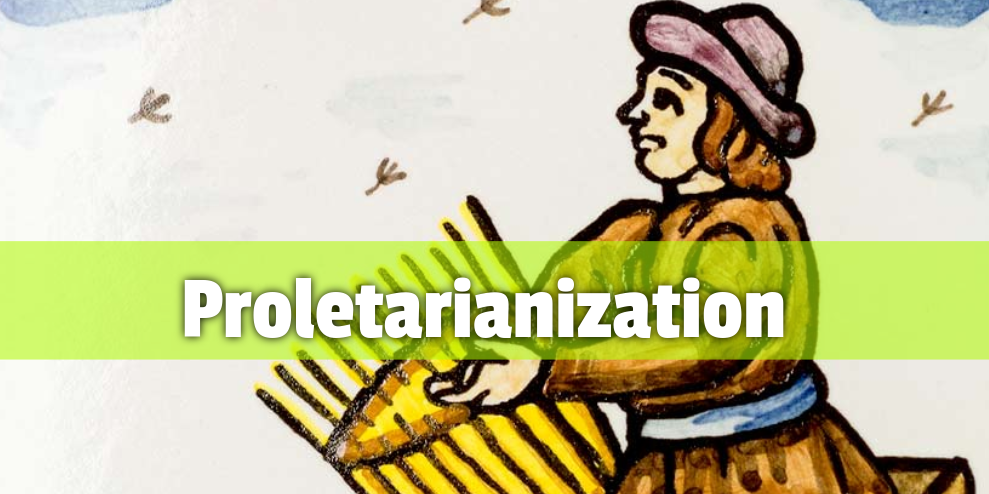Proletarianization

Originally this was the process of transforming independent producers into wage-earning producers of surplus value. It was later expanded to include the integration into the proletariat of the middle strata of bourgeois society.
The proletarianization of the independent peasant and the rural tenant
The main problem that closed the way to the formation of a commodified society in which the vast majority of workers lived in urban areas and did not work any land, was the very low pre-capitalist agricultural productivity. That is why the conditions that make capitalism possible -and different from previous modes of production- must be sought in the countryside, not in the urban centers. The process begins in 16th and 17th century England.
The bourgeoisie and the bourgeois aristocracy imposed two fundamental changes: the nationalization, enclosure and auctioning of communal lands, and the burden of property taxes, which drove the landowners to increase the rents paid by their tenants.
The rise in land rents meant that, in the medium term, productivity had to be increased in order to be able to pay the rents. Lacking the traditional "insurance" of communal land, either the tenants increased the production per person employed or were expelled by the landowners. Increased production will lower food prices and help feed the expropriated peasants who will be forced to work in the fields of the new tenants or flee to the cities to sell their labor. The process pushes the surviving tenants to become capitalist farmers and compete against other capitalists by hiring desperate labor for miserable wages or by forcibly leaving their properties and working as proletarians.
This is the first proletarianization, which takes the inevitable form of rural misery and mass migrations. The two main classes of capitalist society are being created from the transformation of the feudal countryside. By the end of the 18th century almost half the English population was already living in the cities as proletarians, ready to enter the industrial phase of capitalism. A proportion that would not be reached in other European countries, such as Spain, until the mid-1940s.
This process was repeated on the basis of "confiscations" of land wherever the bourgeoisie took power. And from the colonial administrations where the capitalist powers arrived as conquerors. Only in this way could capital escape from the "narrow base" of the strictly capitalist sphere and realize surplus value.
In this first moment, the proletarianization of the independent or integrated producer in a previous mode of production (the day laborer, the guild apprentice, etc.) is merely formal: capital absorbs and exploits his labor but can only increase its profits by increasing absolute surplus value. Then capital will transform that production from the bottom up, developing above all on the increase of relative surplus value, the dominant form in rising capitalism. This two-movement evolution is what Marx called the formal and real subsumption of labor in capital
The proletarianization of the petty bourgeoisie
But the tension toward proletarianization didn't stop with that first blow. With every technological change, small and medium sized capitals will take advantage of the reduction in scale produced by the increase in labor productivity to assert themselves. In doing so, they will open a new branch, a new world of placements for big capital that will end up displacing or absorbing the small pioneer capitals and proletarianizing the small capitalists.
http://dictionary.marxismo.school/ProletarianizationAccording to Marx, the mission of small capitals in the general march of capitalist development is to be the pioneers of technical advance, and this in two ways: by introducing new methods of production in already established branches of production and by creating new branches not yet exploited by big capital. It is completely false to believe that the history of the medium-sized capitalist enterprise is a straight line towards its gradual disappearance. On the contrary, the actual course of its development is purely dialectical and constantly moving between contradictions. The capitalist middle strata, like the working class, are under the influence of two opposing tendencies, one that tends to raise it and the other that tends to lower it. The downward trend is the continuous increase in the scale of production, which periodically exceeds the dimensions of medium-sized capitals, repeatedly expelling them from the arena of world competition. The upward trend is the periodic devaluation of existing capitals, which for a certain time lowers the scale of production, in proportion to the value of the minimum amount of capital required, and furthermore temporarily paralyses the penetration of capitalist production into new spheres. The struggle between medium-size enterprises and big capital should not be imagined as a periodic battle in which the weaker party sees the number of its troops diminish directly more and more, but rather as a periodic mowing of small enterprises, which quickly reappear only to be reaped again by the scythe of big industry. Both tendencies play ball with the capitalist middle strata, but in the end the downward trend triumphs, unlike the proletariat.
Rosa Luxemburg. Reform or Revolution, 1901